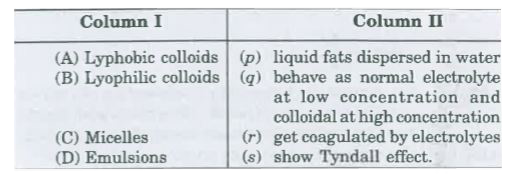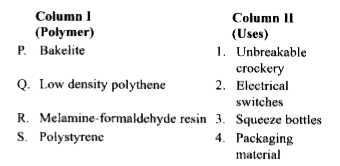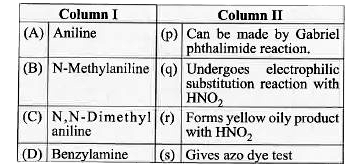Match the entries of Column I with appropriate entries in Column II.

A−(r,s),B−(r),C−(q),D−(p)
Topper's Solved these Questions
- BOOK - MODERN PUBLICATIONCHAPTER - SURFACE CHEMISTRYEXERCISE - COMPETITION FILE (OBJECTIVE TYPE QUESTIONS) (MATCHING LIST TYPE QUESTIONS)2videos
SURFACE CHEMISTRY
- BOOK - MODERN PUBLICATIONCHAPTER - SURFACE CHEMISTRYEXERCISE - COMPETITION FILE (OBJECTIVE TYPE QUESTIONS) (D. MULTIPLE CHOICE QUESTIONS BASED ON THE GIVEN PASSAGE/COMPREHENSION)2videos
SURFACE CHEMISTRY
- BOOK - MODERN PUBLICATIONCHAPTER - SOLUTIONSEXERCISE - UNIT PRACTICE TEST14videos
SOLUTIONS
Similar Questions
Knowledge Check
- Question 1 - Select One
Match the entries of Column I with appropriate entries of Column II and select the correct answer:
 AP-1,Q-2,R-4,S-3BP-4,Q-2,R-1,S-3CP-3,Q-4,R-2,S-1DP-2,Q-4,R-1,S-3
AP-1,Q-2,R-4,S-3BP-4,Q-2,R-1,S-3CP-3,Q-4,R-2,S-1DP-2,Q-4,R-1,S-3 - Question 2 - Select One
Match the entries of Column I with appropriate entries of Column II and select the correct option.
 AP-1, Q-2, R-3, S-4BP-2, Q-3, R-4, S-1CP-2, Q-1, R-4, S-3DP-3, Q-2, R-1, S-4
AP-1, Q-2, R-3, S-4BP-2, Q-3, R-4, S-1CP-2, Q-1, R-4, S-3DP-3, Q-2, R-1, S-4 - Question 3 - Select One
Match the entries of Column I with appropriate entries of Column II and chose the correct option out of the four options (a), (b), (c ) and (d) given at the end of each question.
Column IColumn II(A) Chlorine(p) Transition element(B) Helium(q) Highest electron gain enthalpy(C ) Iron(r ) Highest ionization enthalpy(D) Lithium(s) Strongest reducing agentAA-q, B-r, C-p, D-sBA-p, B-q, C-r, D-sCA-r, B-q, C-p, D-sDA-q, B-p, C-r, D-s
Match the entries of Column I with appropriate entries of Column II and chose the correct option out of the four options (a), (b), (c ) and (d) given at the end of each question.
Column IColumn II(A) Isoelectronic series(p) A++ energy→A+++e−(B) Half - filled(q) Ar, K+,Ca2+(C ) Second ionization enthalpy(r ) Cerium(D) Lanthanoid(s) NitrogenView SolutionMatch the entries of column I with appropriate entries of column II and choose the correct option.
 View Solution
View SolutionMatch the entries of column I with appropriate entries of column II and choose the correct option but of the four options (a), (b), (c ), (d) given at the end of each question.
Column IColumn II(A)Siderite(p)Zinc(B)Chalcocite(q)Aluminium(C)Calamine(r)Copper(D)Bauxine(s)IronView SolutionMatch the entries of column I with appropriate entries of column II.
Compound Magnetic property(A)NaCl(p) Ferrimagnetic(B)MnO(q) Paramagnetic(C)CrCl3(r) Ferromagnetic(D)CrO2(s) Diamagnetic(E)MgFe2O4(t) AntiferromagneticView SolutionGiven that 10 g of a dibasic acid (mol. mass=100) are present in 500 mL of the solution. The density of the solution is 1.02 g ml. Match the entries of column I with appropriate entries of column II and choose the correct option.
 View Solution
View Solution



